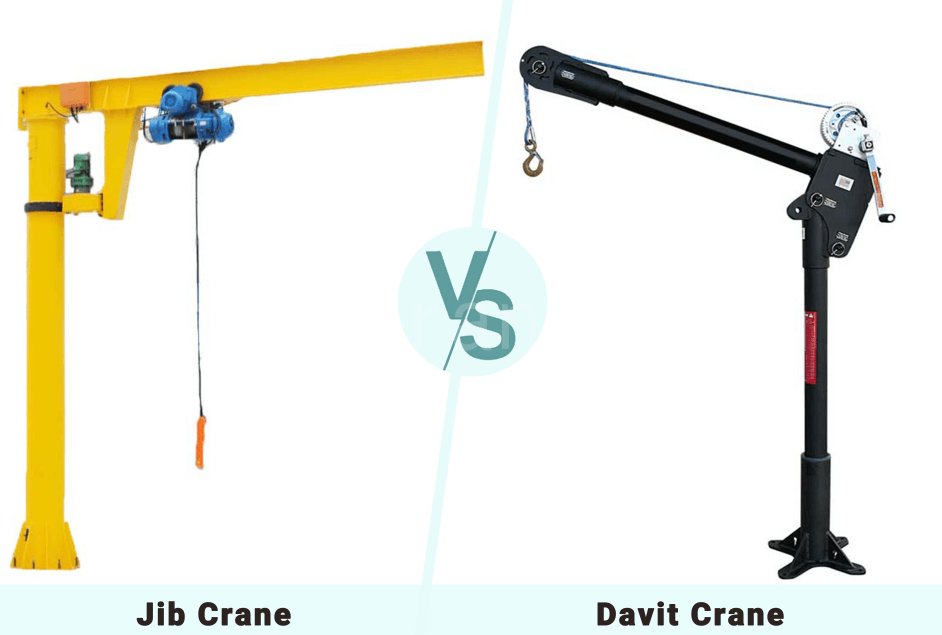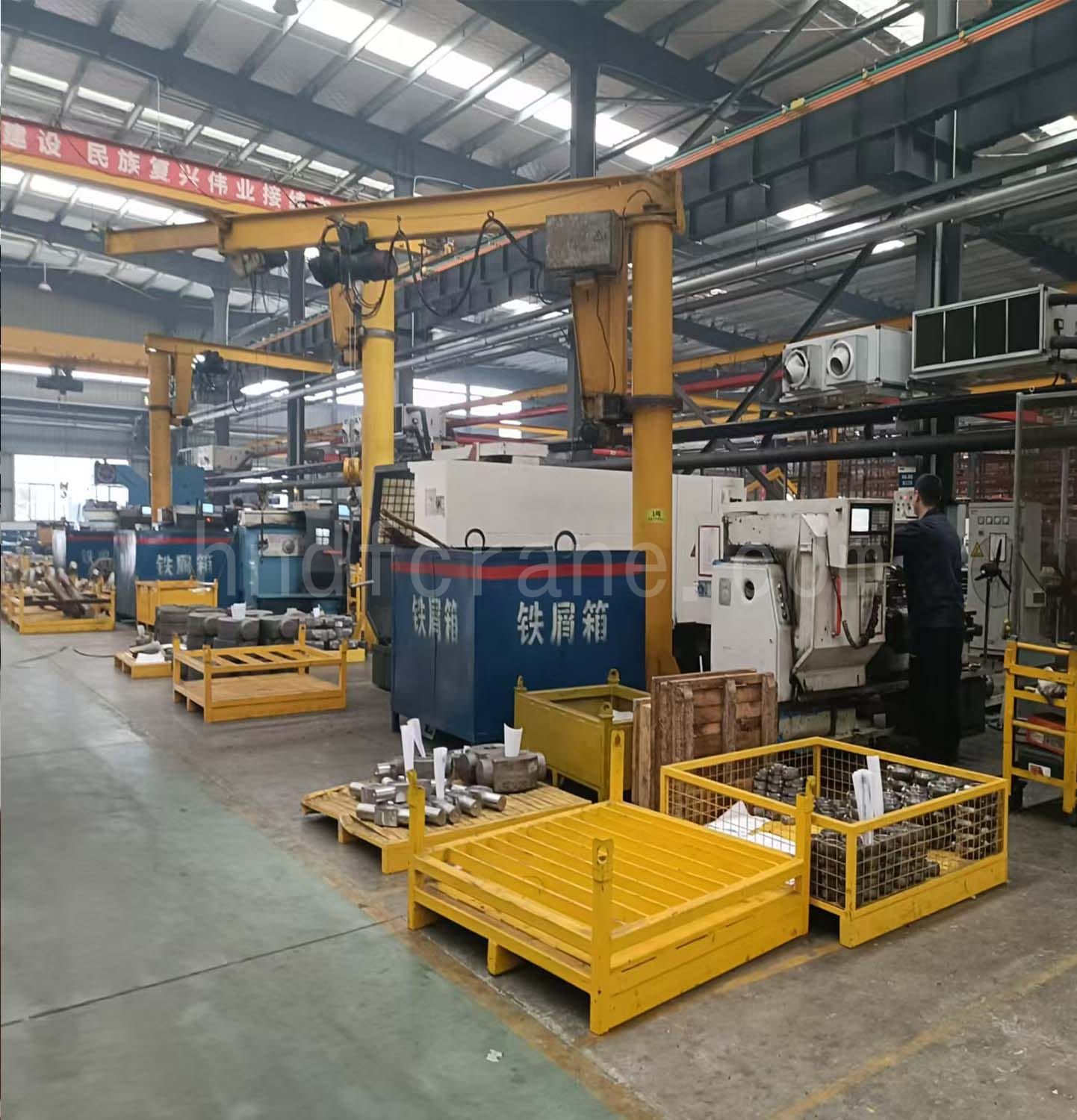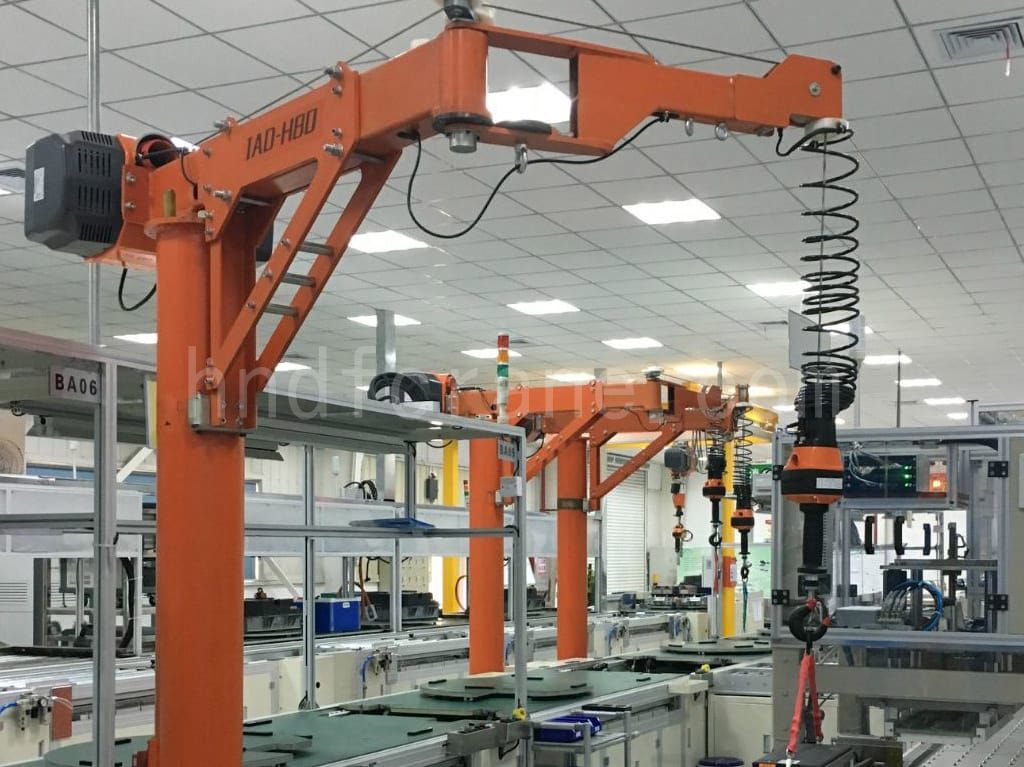เครนแขนหมุนและเครนเดวิท: ความแตกต่างหลัก 4 ประการ
สารบัญ

เครน Davit และเครน jib มักใช้ในอุตสาหกรรมและการก่อสร้างร่วมกัน เนื่องมาจากเครนเหล่านี้มีลักษณะและการใช้งานที่คล้ายคลึงกัน เช่น เครน Davit และเครน Jib มักทำด้วยเหล็กและใช้ในการยกหรือลดอุปกรณ์ในสภาพแวดล้อมต่างๆ
อย่างไรก็ตาม นอกเหนือจากความคล้ายคลึงกันที่ผิวเผินเหล่านี้แล้ว ยังมีความแตกต่างที่สำคัญในด้านการออกแบบ ฟังก์ชัน และสถานการณ์การใช้งานของเครนเดวิทและเครนบูม การทำความเข้าใจความแตกต่างหลักเหล่านี้ไม่เพียงแต่ช่วยให้คุณเลือกอุปกรณ์ยกที่เหมาะกับความต้องการของคุณมากที่สุดเท่านั้น แต่ยังช่วยปรับปรุงประสิทธิภาพการทำงานและความปลอดภัยอีกด้วย บทความนี้จะวิเคราะห์ความแตกต่างหลัก 4 ประการระหว่างเครนเดวิทและเครนบูมอย่างละเอียด และสำรวจว่าเหตุใดในบางกรณี วิธีการเลือกเครนบูมจึงสามารถให้ประโยชน์ต่อการทำงานของคุณได้มากขึ้น
1.การเปรียบเทียบการใช้งาน
เครนยกของ

ใช้บนหลังคาโรงงาน

ใช้เพื่อการบำรุงรักษาถนน

ใช้ในประมงทะเล
เครนแขนโยก

ใช้ในการกลึงชิ้นส่วนและส่วนประกอบเพื่อให้การยึด การโหลดและการขนถ่าย และการถ่ายโอนชิ้นงานของเครื่องมือเครื่องจักรเสร็จสมบูรณ์

ใช้สำหรับยกและระบุตำแหน่งอุปกรณ์และเครื่องจักรในระหว่างการซ่อมแซมและบำรุงรักษา

ใช้งานสำหรับการโหลดและยกสินค้ากลางแจ้ง
2.การเปรียบเทียบคุณสมบัติ
เครนยกของ
- ขนาด :
โดยทั่วไปมีขนาดเล็กและกะทัดรัดกว่า - ความจุ: ภายใน 1 ตัน
- แหล่งจ่ายไฟ : ทั่วไปเป็นไฟฟ้า
- ความเร็วในการยก : ความเร็วต่ำ (รอกสลิง)
- ความสูงในการยก: ต่ำลง
- ความอเนกประสงค์: เฉพาะทางมากขึ้น มักใช้เพื่อวัตถุประสงค์ทางทะเลหรือการบำรุงรักษา สามารถใช้งานได้หลายตำแหน่ง บูมสามารถปรับได้อย่างยืดหยุ่น
- กำหนดเอง: ปรับแต่งได้สูงพร้อมตัวเลือกมากมาย
- ความคล่องตัว: สูง (น้ำหนักเบา พกพาสะดวก โดยปกติไม่จำเป็นต้องใช้รองพื้น)
- การติดตั้ง: สามารถวางได้อิสระ ติดผนัง หรือพกพาได้ เคลื่อนย้ายสะดวก ติดตั้งง่าย ใช้งานง่าย (ใช้งานกับวินช์ หมุนบูมได้ในระยะปลอดภัย)
- การหมุน: เครน Davit เป็นแขนแบบยืดหดได้ ปรับมุมแขนได้ และหมุนตามทิศทางของความสูง สามารถปรับความสูงและรัศมีการทำงานได้

- ความยืดหยุ่น: สามารถพกพาได้ พกพาสะดวก และมีน้ำหนักเบา สามารถทำจากวัสดุคาร์บอนไฟเบอร์แบบผสมซึ่งมีน้ำหนักเบาและสะดวกสำหรับเซสชันพิเศษ วิธีการติดตั้งที่หลากหลายสามารถปรับให้เข้ากับสภาพการทำงานที่แตกต่างกันได้

เครนแขนโยก
- ขนาด :
โดยทั่วไปมีขนาดใหญ่กว่า - ความจุ: สูงสุด 10 ตัน
- แหล่งจ่ายไฟ : ทั่วไปเป็นไฟฟ้า
- ความเร็วในการยก : เร็วกว่า (รอกสลิง/รอกโซ่)
- ความสูงในการยก: สูงกว่า
- ความคล่องตัว: ใช้กันอย่างแพร่หลาย เหมาะสำหรับการใช้งานในอุตสาหกรรมต่างๆ พื้นที่ทำงานคงที่ และความยืดหยุ่นของบูมไม่ดี ปรับแต่งได้: ปรับแต่งได้สูงด้วยตัวเลือกต่างๆ มากมาย
- ความคล่องตัว: สูง (น้ำหนักเบา พกพาสะดวก โดยปกติไม่จำเป็นต้องใช้รองพื้น)
- ปรับแต่ง: ปรับแต่งไม่ดี
- การติดตั้ง: โดยทั่วไปแล้วสามารถเคลื่อนย้ายได้หรือติดตั้งชั่วคราว โดยปกติจะติดตั้งแบบถาวร แต่การติดตั้งแบบถาวรนั้นซับซ้อนกว่า (การทำงานของรอกโซ่ ต้องเข้าถึงโหลด)
- การหมุน: แขนเครนบูมไม่สามารถหดกลับได้ ไม่สามารถยกขึ้นหรือลงได้ และการหมุนมีจำกัด ความสูงไม่สามารถเปลี่ยนแปลงได้

- ความยืดหยุ่น: ใช้การติดตั้งแบบตายตัว ต้องมีฐานรากที่ฝังไว้ล่วงหน้า และมีน้ำหนักมาก

3.การเปรียบเทียบแนวคิด
เครนเดวิทคืออะไร-
เครนเดวิทเป็นเครนพกพาซึ่งโดยทั่วไปประกอบด้วยเสาหรือเสาแนวตั้งและแขนหรือบูมแนวนอน (เรียกว่าเดวิท) ชื่อของเครนมาจากคำว่า "เดวิท" ซึ่งเดิมหมายถึงเครนขนาดเล็กที่ติดตั้งบนเรือเพื่อยกเรือชูชีพ อย่างไรก็ตาม ปัจจุบันเครนเดวิทถูกนำมาใช้กันอย่างแพร่หลายในอุตสาหกรรมและการใช้งานต่างๆ เนื่องจากมีความสามารถในการพกพาและใช้งานง่าย
เครนแขนหมุนคืออะไร?
เครนแขนหมุน หรือที่เรียกอีกอย่างว่าเครนแขนหมุน หรือเครนแขนหมุน คือเครนที่ประกอบด้วยแขนแนวนอนที่เรียกว่าแขนหมุนหรือบูม เชื่อมต่อกับเสาหรือเสาแนวตั้ง เครนแขนหมุนได้ชื่อมาจากการเคลื่อนที่แบบส่วนโค้งที่ทำได้ ซึ่งคล้ายกับการแกว่งของใบเรือแขนหมุนบนเรือใบ
โดยทั่วไปแล้วเครน Davit จะมีขนาดเล็กกว่าและมีความเป็นมืออาชีพมากกว่าเครนแบบคานยื่น เครน Davit มักใช้ในงานทางทะเลหรือยกอุปกรณ์ขึ้นบนแท่นยกที่ยกสูง
4.การเปรียบเทียบการจำแนกประเภท
เครนยกของ

เครนเสาคอมโพสิต

เครนยกของคาร์บอนไฟเบอร์

เครนยกของเหล็ก
เครนแขนโยก

เครนแขนหมุนแบบปรับได้
สรุป
โดยสรุปแล้ว จากการเปรียบเทียบเครนเดวิทและเครนบูมอย่างละเอียดใน 4 ประเด็นหลัก (ข้อมูลพื้นฐาน การจำแนกประเภท การใช้งาน และคุณลักษณะ) เราได้เน้นย้ำถึงข้อได้เปรียบเฉพาะและกรณีการใช้งานที่เหมาะสมของแต่ละประเภท เครนบูมโดดเด่นด้วยความยืดหยุ่นและความคล่องตัว ทำให้เหมาะอย่างยิ่งสำหรับสภาพแวดล้อมทางอุตสาหกรรมที่ต้องการระยะการทำงานที่กว้างและการเปลี่ยนตำแหน่งบ่อยครั้ง ในทางกลับกัน เครนบูมขึ้นชื่อในด้านความทนทานและฟังก์ชันเฉพาะทาง โดยเฉพาะอย่างยิ่งเหมาะสำหรับการใช้งาน เช่น การจอดเรือและการบำรุงรักษาอุปกรณ์
เมื่อต้องตัดสินใจเลือก บริษัทต่างๆ ควรประเมินความต้องการในการดำเนินงานเฉพาะ ข้อจำกัดด้านงบประมาณ และสภาพแวดล้อมอย่างรอบคอบ การหาจุดสมดุลระหว่างข้อดีและข้อจำกัดของเครนเดวิทและเครนบูมจะช่วยให้บริษัทสามารถเลือกตัวเลือกที่เหมาะสมที่สุดได้ ความเข้าใจอย่างลึกซึ้งเกี่ยวกับความแตกต่างระหว่างเครนทั้งสองประเภทไม่เพียงแต่ช่วยเพิ่มประสิทธิภาพการกำหนดค่าอุปกรณ์เท่านั้น แต่ยังช่วยปรับปรุงประสิทธิภาพการทำงานและรับประกันผลประโยชน์ทางเศรษฐกิจที่มากขึ้น รวมถึงมาตรฐานความปลอดภัยที่สูงขึ้นอีกด้วย
ท้ายที่สุดแล้ว การตัดสินใจเลือกระหว่างเดวิทและเครนบูมอย่างรอบรู้สามารถมีส่วนสนับสนุนต่อความสำเร็จโดยรวมและผลผลิตขององค์กรได้อย่างมาก
ส่งคำถามของคุณ
- อีเมล: sales@hndfcrane.com
- วอทส์แอพพ์: +86-191 3738 6654
- โทร: +86-373-581 8299
- แฟกซ์: +86-373-215 7000
- เพิ่ม: Changnao Industrial District, Xinxiang City, Henan Province, China









































































